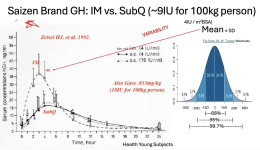We do not have in-vivo mechanistic research on why tesa would work more on VAT than GH and even the proposed reasoning by ChatGPT in the followup post after makes no sense - exogenous HGH would also bind more to VAT if it is a matter of increased receptor density. Plenty of people inject HGH before bed and we know from lots of other research (primarily around IM vs SubQ injections with HGH) that ChatGPT is just flat out wrong in saying that exogenous HGH results in sustained GH levels - it is VERY spikey, even in SubQ, though IM increases this further. And I don't see how tesa couldn't work on subcutaneous fat - even totally natural GH production induces lipolysis in subcutaneous fat cells.I think the distinction is that tesa only works on visceral fat, it does not have an effect on subcutaneous fat. HGH has an effect on both. I am also non-expert but that’s how i understand it, if you want to know the mechanism I bet chatgpt could tell you.
The IGF-1 levels are sustained, unlike GH, but they are with secretagogues as well, and it is the GH itself that induces lipolysis.

See above - a lot of this is just flat out inaccurate or doesn't make much sense when reasoned through.As a GHRH I automatically wanted to default to that, but the clinical data on Tesa's effects on visceral fat are aggressive vs GH's, looks like there IS a difference in how they stimulate lipolysis, but we dont have a 'why':
(Per ChatGPT4)
Whereas GHs mechanics seem to target all fat deposits evenly:
maybe at a certain dose GH is blunting the fat loss its also responsible for? maybe this is one of Exogenous GH's shortcoming that Endogenous GH stimulated by Tesa is incabale of mimicking? Who knows.
It is important to remember that LLMs are word association programs and we should not take what they say as gospel.
With that in mind, I asked ChatGPT to focus on this more specifically and try to explain things, and this was it's ultimate answer. Clipped for brevity since it gave me a very long answer from research mode. Take it with a grain of salt.
Putting it all together
- Evidence for a qualitative difference (VAT‑selective vs “all‑fat”) is weak. The apparent selectivity of tesamorelin largely stems from dose and pattern used in trials, not from an intrinsic impossibility for rhGH to do the same.
- When GH exposure is supraphysiologic and more continuous (rhGH 4 mg), subcutaneous fat loss and insulin resistance are more pronounced.
- If you titrate nightly rhGH to yield IGF‑1 in the same range tesamorelin achieves (~+1 SD) and/or split it into true pulses, you would expect similar VAT reduction with fewer metabolic downsides—but this has not been formally tested.
- In-vitro studies suggest secretagogues retain normal feedback, mixed isoforms and possible direct adipocyte actions, so the exact equivalence cannot be assumed.
Bottom line for practice
- Secretagogues (tesamorelin, ibutamoren, ipamorelin + CJC‑1295, etc.) are a proven way to shrink VAT with a comparatively clean metabolic profile.
- rhGH can achieve comparable or larger VAT loss, but only if care is taken with dose, timing and monitoring of IGF‑1 and glucose.
- Claims that “HGH works on all‑body fat while secretagogues only target visceral fat” oversimplify the literature—both mobilise fat everywhere; the pattern and magnitude of exposure dictate the depot response.
So far, the question is unresolved mainly because no rigorously designed head‑to‑head study exists. Mechanistic clues suggest mostly quantitative (pulse shape, isoform mix, direct GHRH effects) rather than qualitative differences.
I'll note that the 4mg HGH mentioned in the reference study would be quite a high HGH dose - HGH is 3IU/mg, and most people trying to mimic a similar effect to secretagogues are going to be in the 2-4IU range. You're well into bodybuilder territory at that point.
Last edited:

